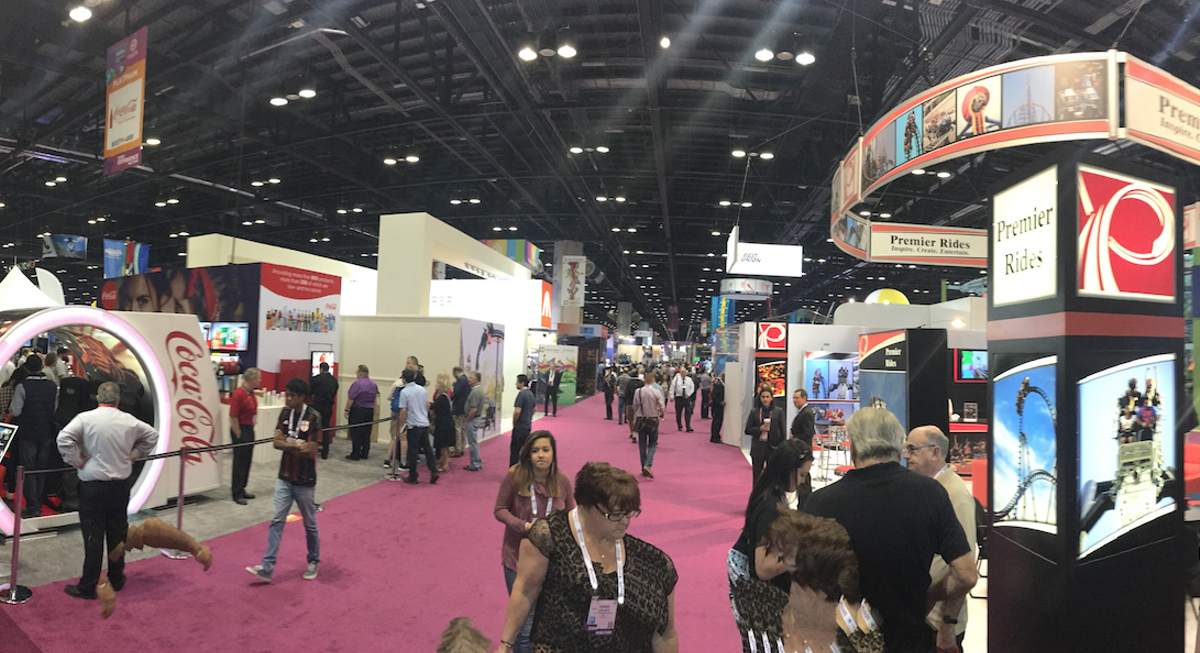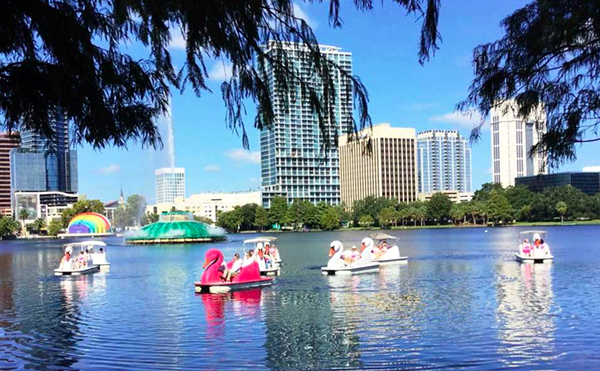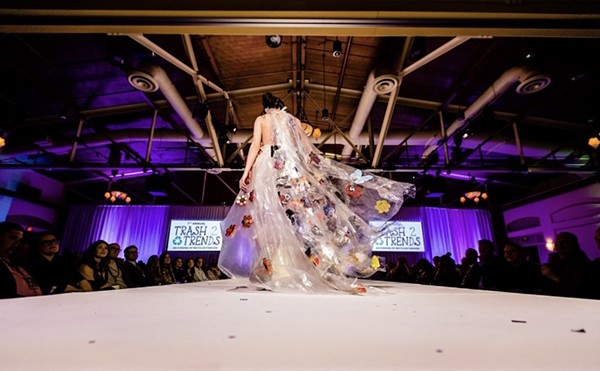It might be tough to think of things to be thankful for this turkey day, but if nothing else I'm grateful that I got to attend my 10th IAAPA Expo last week. The largest-ever annual International Association of Amusement Parks and Attractions trade show at the Orange County Convention Center once again left me elated and exhausted by its endless aisles of dazzling displays, dizzying rides and fattening fair food. But even inside that wonderland of fantasy, I kept noticing that some of the same tensions tearing apart the real world – high-tech versus high-touch, progress versus tradition, community versus individuality – are also apparent within the theme park universe.
If last year's IAAPA was the coming-out party for virtual reality, 2016's expo was the technology's huge tacky wedding, with an acrimonious divorce liable to follow before the decade is out. Everyone from major ride manufacturers to unknown Asian vendors was luring in attendees with head-mounted goggles with varying degrees of goofiness. Samsung's GearVR smartphone-based wireless headsets are on fire (figuratively, for a change), providing the most popular and reliable VR solution, with the tethered HTC Vive and Oculus Rift systems taking a distant second place. At the booth Oceaneering and Falcon's Creative shared, I had my first hands-on with Microsoft's HoloLens mixed reality glasses, which superimpose ghostly images over the real world if you manage to tilt your head at the exact right angle and squint.
After sampling nearly every VR demo on the vast show floor, I found few advances over the Aladdin flying carpet simulator demonstrated at Epcot's Innoventions more than 20 years ago. At its best, as when paired with a simulator like DOF Robotics' 360-degree spinning Hurricane, VR is a seductive alternative to expensive sets and animatronics. At its worst, like UNIS Omni Arena's absurd slip-sliding treadmill, you're left with little more than eyestrain and sore legs. While I loved MACK's VR installation on Fun Spot's Freedom Flyer coaster, the headsets are still too clumsy and unhygienic to succeed on a major attraction; DreamCraft Attractions previewed a modular model with washable face-masks, but hourly capacity remains a nearly insurmountable challenge. VR may yet be a boon for attraction designers – Polin Waterparks had a nifty raft simulator that let you ride yet-unbuilt waterslides, sans splashing – but Mediafront's vertigo-inducing skyscraper sim was the only VR immersive enough to make my knees knock.
If a vendor at IAAPA 2016 wasn't trying to sell a VR headset, it was probably only because they were too busy hawking a Flying Theater, which seems to be the current "next big thing" in motion simulators. Cavu, Vekoma, Simworx, Triotech and countless others now offer dangling-feet designs, but the one to watch is DyMoRides; the company impressed me at my first IAAPA with their Flyboard concept, and now it appears their designs will underpin Jimmy Fallon's new ride at Universal Studios Florida. Ironically, while Dynamic Attractions started the flying theater craze by building Epcot's Soarin' and recently opened their next-gen version in Seattle, they've advanced far beyond it with their innovative new Motion Theater concept, which wraps large-screen projections and live sets around a rotating audience.
Whether we're talking flying theaters or photo booths, the biggest buzzword at IAAPA, as always, was "interactivity." Maurer's new Spike monorail coaster has a digital display and allows riders to adjust their speed; Alterface has added mechanics wrenches and magic wands to their inventory of light zappers; Triotech is building Ghostbusters and Fear the Walking Dead shooting attractions in Germany and Las Vegas; and the interactive pioneers at Sally unveiled a Five Nights at Freddy's ride concept, where you use security doors and flashlights to ward off evil animatronics. That's not even mentioning arcade games, which were dominated by The Walking Dead crossbow shooting gallery and supersized versions of Pac-Man and Space Invaders. But my favorite example of digital interaction was the simplest and most sociable: the ZTag zombie scavenger hunt, featuring an LED pin that flashes colors as you "infect" or "heal" other players in your proximity.
Ultimately, after all the pixels were processed, the products that appealed most to me were decidedly low-tech, like Lake Mary inventor Joe Donoughe's "Be the Hamster" human-powered snow cone maker, or sculptor Fredrick Prescott's whimsical wind-animated animals. Fortunately, after all the virtual reality left me feeling disconnected and dispirited, the Hall of Fame and Legends panels hosted by Bob Rogers offered inspiring stories from actual reality, shared by industry giants like Disney's Marty Sklar and Dick Nunis, Cedar Fair's Dick Kinzel, and attractions journalist Tim O'Brien. The unsolicited advice from Shanghai Disneyland's designers to their competitors constructing Universal Studios Beijing is applicable to any endeavor: Have patience and be willing to compromise, but be clear about things you can't compromise on; always overestimate the amount of oversight, time and staff required; and most importantly, know your audience.

















